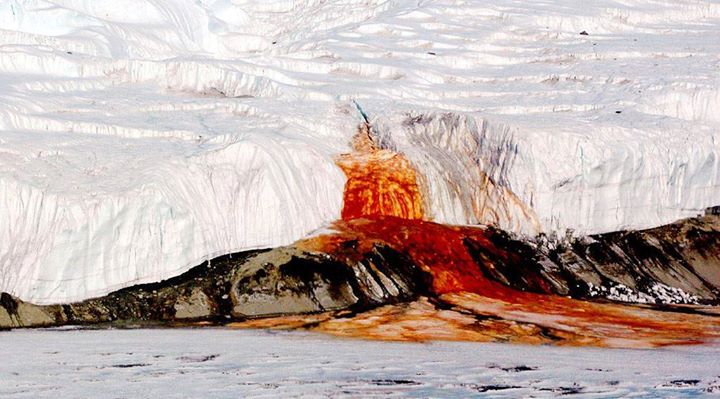Blood Falls, named for its blood like color, is not in fact a gush of blood from some unseen wound. Blood Falls is actually an outflow of an iron oxide-tainted plume of saltwater, flowing from the tongue of Taylor Glacier onto the ice-covered surface of West Lake Bonney in the Taylor Valley of the McMurdo Dry Valleys in Victoria Land, East Antarctica.
Iron-rich hyper-saline water emerges at irregular intervals from small fissures in the ice cascades. The saltwater source is a sub glacial pool of unknown size covered by about 400 metres (1,300 ft) of ice several kilometers from its tiny outlet at Blood Falls.
The reddish deposit was found in 1911 by the Australian geologist Griffith Taylor, who first explored the valley that was names after him. The Antarctica pioneers first attributed the red color to red algae, but later it was proven to be due to iron oxides.
Located in Antarctica’s McMurdo Dry Valleys, the falls come out from Taylor Glacier, and the liquid bubbles up from crack in the glacier’s surface.
Know Before You Go
The Dry Valleys are only accessible by helicopter from McMurdo Station (U.S.), Scott Base (New Zealand) or a cruise ship in the Ross Sea.
Theories
The flow was previously a mystery, as the mean temperature in that area is 1.4 degrees Fahrenheit (-17 degrees Celsius) the temperature at which even water is solid and liquid from Blood falls was flowing liquid.
A. Salt Lake
Blood Falls is not the melted residue of Taylor Glacier, which is a typical continental glacier, descending from a plateau on the Antarctic Ice Sheet about 54 kilometers (35 miles) away.
Instead, Blood Falls is a plume rising from an ancient hyper-saline lake trapped beneath Taylor Glacier’s 400 meters (1,312 feet) of ice. About 5 million years ago, the ocean flooded East Antarctica, creating a salty inland lake. Around 3 million years later, glaciers formed over the saline lake, trapping a basin of pristine saltwater that has been isolated for nearly 2 million years.
As water on the surface of the sub-glacial lake froze, the liquid below became even saltier. As liquid was removed from the lake (to form solid ice), the lake’s salt became more concentrated in the remaining water. Today, the water is about three times as salty as the ocean—salty enough that it won’t freeze, even in temperatures dipping well below the freshwater freezing point of 0° Celsius (32° Fahrenheit).
As Blood Falls gushes out of Taylor Glacier, it empties into Lake Bonney, a permanently ice-covered lake. Blood Falls’ outflow helps make Lake Bonney saline, although not nearly as salty as Blood Falls’ source lake.
B.Rust Falls
Blood Falls source lake is not actually red. Its sub-glacial conditions exclude oxygen and light, but include large amounts of iron. The salty, iron-rich water only becomes red as it interacts with the oxygen-rich surface environment at the falls, a complex chemical reaction called oxidation.
Reddish particles form as a result of a chemical reaction between iron and oxygen. The presence of salt increases the rate of this reaction, allowing the salty water at Blood Falls to appear bright red as it trickles down the glacier.
A similar oxidation process makes our own salty, iron-rich blood appear red when it comes into contact with air through a nosebleed or scraped knee.
Conclusion
The existence of the Blood Falls ecosystem shows that life can exist in the most extreme conditions on Earth. Though tempting to make the connection, it does not prove, however, that life could exist on other planets with similar environments and similar bodies of frozen water—notably Mars and Jupiter’s moon Europa—as such life would have to arise from a completely different chain of events.
Even if it doesn’t confirm the existence of extraterrestrial life, Antarctica’s Blood Falls is a wonder to behold both visually and scientifically.







No comments:
Post a Comment